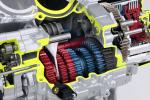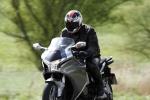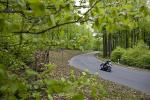Honda Dual Clutch Transmission
By Kevin Ash - 24/09/2012
Rather oddly, Honda stresses that the new Dual Clutch Transmission fitted to the VFR1200F is not an automatic transmission, but electronic manual transmission. Yet it patently is automatic!
You can select drive, open the throttle and the bike pulls away and changes gear, up and down, with no further input from the rider. That‘s automatic transmission.

More importantly, semantics aside, it works, and it works very well. There are three modes to choose from: Touring, Sport and Manual, toggled through a switch on the right handlebar. Press the button and incongruously, there‘s exactly the same clunk you get on the manual VFR when you pull in the clutch lever and engage first, although this shouldn‘t really be a surprise as that‘s exactly what the electronics are doing. The gearbox and selector forks are exactly the same as any familiar manual sequential motorcycle transmission, the difference is only that they‘re operated by electronics and hydraulics. Oh, and there are two clutches-

We‘ll select manual mode to explain how this works, operated by a couple of buttons on the left handlebar. Clutch one operates on the even numbered gears, 2nd, 4th and 6th, clutch two operates the odd gears, 1st, 3rd and 5th. In first gear, clutch one is engaged while second gear is already pre-selected but kept disengaged by clutch two. Accelerate, keep the throttle open then push the button to change up, and clutch one disengages first gear just as clutch two engages second, swopping you from first to second gear in an instant. At the same time, third gear is selected ready for the next up-change but for now is kept disengaged by clutch one. Then as you reach the redline, push the button again and clutch one engages the pre-selected third gear as clutch two disengages second, and now you‘re in third, still on full throttle. And so it goes on up to sixth, smooth and super fast.

Down-changes can take a little longer, as the system sometimes has to select the lower gear first instead of the higher one before it can switch the clutches, but this is no problem as it gives it time to blip the throttle to bring up the engine revs for a smooth transition. And the system often predicts you‘re going to be changing down anyway by looking at the brakes and road speed, and it then pre-selects the lower gear.
Pulling away is controlled by the same hydraulics that operate the clutches and the gear selection, engaging the clutch at a predetermined rate according to revs, acceleration and throttle opening.

That‘s the theory, and in practice it hangs together well, although it‘s not possible to really slip the clutch for very fast, full throttle getaways, the bike just moves off the line smartly if you snap the throttle wide open, which is a bit disappointing. The take up is very smooth though, and the bike will trickle along down to creeping forward speeds with none of the lurching and jerkiness which mar Yamaha‘s automatic FJR1300.
In Touring mode though the bike is pretty slow. Even on full throttle it barely allows half of maximum revs, and the rest of the time it changes up even sooner, then hangs on to high gears for disconcertingly long when you‘re slowing down again. The engine is smooth enough to deal with it, but as it lacks low rev torque the main sensation is one of lethargy.

Rather naughtily, Honda claims the DCT VFR uses less fuel than the manual version, but this is only because of this low revving, gentle nature of Touring mode. If you rode a manual VFR in exactly the same way, it would be more, not less, economical than the auto. This is because the auto bike is 22lb (10kg) heavier, as well as always having one clutch ‘pulled in‘ and therefore dragging its plates, and also because the two hydraulic pumps that operate the clutches take a significant amount of power from the engine. It‘s a bit like driving a car with the air con switched on: fuel economy suffers.
Sport mode is more interesting, and it even lets the motor rev right up to the red line if you‘ve got the throttle pinned wide open. The rest of the time the bike revs higher than in Touring mode, although when you hit a straight after a series of twisty corners, it hangs on to the lower gear at a steady speed where on a manual you‘d change up until you get to the next corner.

But the gearchanges themselves, in either automatic mode, are astonishingly fast and smooth, almost imperceptible much of the time, and satisfyingly the bike even does a small blip of the throttle when changing down at high speeds and revs in Sport mode and manual.
Switch again to manual and enjoy the novelty of changing gear with thumb and forefinger. Once more the changes are seamless, and this time you have more control so you can always be in the gear you want, when you want (as long as the bike thinks it‘s safe for the engine- it won‘t let you change down if it means over-revving, for example).

It‘s fun because it‘s different, but what happens when the novelty value wears off? Then it gets harder to justify. As well as increased weight and fuel consumption (although I‘ve not measured that, but Honda did agree this could be the case) - both traits the VFR1200F of all bikes hardly needs - in the automatic modes it can get irritating when the bike isn‘t in the gear you‘d have chosen yourself. That‘s not just me being over-sensitive, it does affect your riding, for example making you guess at the amount of engine braking you‘ll be getting as you dive into a corner.

I also found low speed riding awkward in situations where I‘d normally give a quick dip of the clutch, such as pulling out of a small side road onto a narrow main road at low speed - I tend to feather the clutch to help control the lean and trajectory of the bike, but with DCT all you get is the throttle for this. It‘s not bad, but it‘s not quite as easy as having a clutch as well, and it‘s the same in very slow, uphill hairpins where you might normally slip the clutch for really fine control. And I‘ve never found changing gear with my foot much of a chore anyway, certainly not a £1000 chore, which is what the DCT option will cost on the VFR when it appears at dealers in June 2010.

The system does work extremely well, far better than the flawed Yamaha automatic on the FJR. The question really is whether it‘s worth that money to replace a system that‘s easy enough anyway, especially as it does take away the most precise control you have and make life a little bit more difficult in very slow speed manoeuvring. There are no maintenance requirements in addition to the manual VFR's needs, so nothing to put you off there, but add the weight and likely economy penalties to the £1000 premium over a manual VFR and for most, the answer has to be no.
Donate to the Kevin Ash Fund
Kevin's funeral was held on Thursday 28th February 2013 and was well attended by family, friends and colleagues.
The Telegraph has very kindly established The Telegraph Kevin Ash Fund to assist with the education of Kevin's three daughters.
If you'd like to make a donation then you can use the PayPal 'Donate' button below which will allow you to donate from your PayPal account, or via credit or debit card. A small percentage (about 3.4%) will be retained by PayPal for the service.
Kevin's family have been touched by the generosity and messages of support from people using the website and would like to express their gratitude to those who have contributed in any way.
The donations keep coming in, thank you so much, and the family especially like it when you leave a message.
Home | ![]() facebook.com/KevinAshFund
|
facebook.com/KevinAshFund
| ![]() twitter.com/KevinAshFund | © 2012
twitter.com/KevinAshFund | © 2012